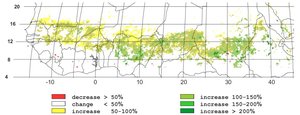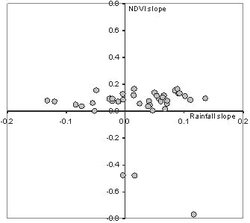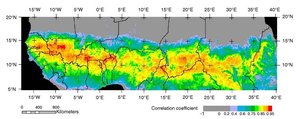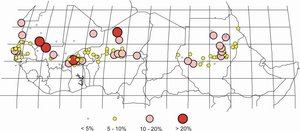Greening of the Sahel
Contents
Greening of the Sahel
Introducing the issue
The Sahel region in Africa, spanning the entire continent from the Atlantic Ocean to the Red Sea, receives, in the main, the World’s attention in cases of drought, famine or political crisis. The Sahel is a dynamic ecosystem that responds not only to climatic variability bu to human exploitation of biospheric resources. Over the long-term, changes in rainfall may have resulted in changes in land use patterns. While there has been a tendency to refer such changes as the desertification of the Sahel, results from analysis of different types of satellite- and ground-based data have not resulted in consensus on the direction of changes.
Since the early 1980s, global satellite mapping of the biosphere has generated long time-series measurements of vegetation that can be used as proxies for understating the dynamics of variability of the Sahel's ecological system. A number of studies using these and other data have shown the close coupling among rainfall, land use and primary production in the Sahel.
Short environmental history of the Sahel
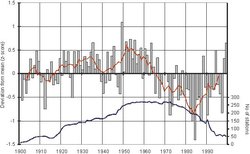 Figure 1. Rainfall anomalies from the long term mean for meteorological stations in the Sahel. Red line shows the 7 year running mean, blue line shows the number of stations included in the calculation of z-score. (Source of data: Climatic Research Unit, University of East Anglia, and Global Historical Climatology Network, Oak Ridge National Laboratory)
Figure 1. Rainfall anomalies from the long term mean for meteorological stations in the Sahel. Red line shows the 7 year running mean, blue line shows the number of stations included in the calculation of z-score. (Source of data: Climatic Research Unit, University of East Anglia, and Global Historical Climatology Network, Oak Ridge National Laboratory) For the last four decades there has been sustained scientific interest in contemporary environmental change in the Sahel. The area and its peoples suffered several devastating droughts and famines between the late 1960s and early 1990s. The scientific debate about the climatology of these droughts is still ongoing. Also, the causes of the famines have been a topic of intense discussion for several decades. Even the very existence of a decline in rainfall over the Sahel (Figure 1) has also been questioned but these doubts were fiercely and profoundly rebutted.
In Figure 1 a summary of rainfall anomalies across the Sahel over the last 100 year is presented.
The discussion of the relative importance of climatic versus human causes of vegetation change in the Sahel began as early as the 1930s and is still continuing. Discussion intensified after more recent droughts in the 1970s and 1980s. The early discussion emphasized the role of human overexploitation, such as overgrazing, overcultivation and the cutting of trees, while the discussion more recently has become more balanced in terms of invoking both human and natural causes as well as the dynamic linkages between them.
The first and the most well known mechanism was proposed in the mid 1970s by Otterman and Charney and often referred to the “Charney hypothesis”, by which albedo increases, due to overgrazing and cultivation, leads to a general cooling of the land surface and thereby reductions of evapotranspiration and of surface air convergence, leading to reductions of cloudiness and rainfall. This chain of effects was hypothesized to cause a positive feed back loop responsible for the persistent drought in the Sahel. Model studies using the Goddard Institute for Space Studies (GISS) general circulation model (GCM) suggested that albedo changes from 14% to 35% over all continents’ desert areas would sharply reduce clouds and rainfall. These results were, however, contested by Ripley, claiming that the model did not adequately treat the role of evapotranspiration in regulating surface temperature and also that the albedo changes assumed were much larger than might be supported by observations. According to Ripley, regions with higher albedo are generally hotter than their surroundings due to the lower rate of evapotranspiration, a conclusion supported by a study using the NCAR GCM. The Otterman-Charney mechanism was further questioned based on studies in the Sonoran Desert in Mexico, claiming that denuding the soil may have completely opposite thermal and climatic effects.
More recently, a number of modelling studies have concluded that vegetation changes play a significant role in the rainfall variability of the Sahel but so far a convincing explanatory mechanism is elusive. The study by Zeng et al. also showed that SST forcing was a less important explanatory variable than vegetation dynamics during the modelling period 1900 to 1998. Shukla et al. studied the role of desertification, i.e. vegetation removal in the Sahel, by means of a coupled ocean-land climate model. They concluded that the desertification scenario decreased the rainfall. However, their assumptions about vegetation change were unrealistic and the actual mechanism by which the rainfall is reduced was not clear.
Recent results from global climate modelling, however, suggests a strong link between sea surface temperature (SST) anomalies and rainfall in the Sahel region. Using a GCM and a number of SST scenarios, Giannini et al. were able to reproduce much of the observed rainfall variation (1930–2000) in the Sahel and also explain some 25–35% of inter-annual rainfall variations. Local to regional interaction between vegetation and rainfall was also shown to be linked to the variability of Sahel rainfall.
The greening of the Sahel
After several decades of declining rainfall and dwindling food production in the Sahel, reports telling a different story started to appear. Analyses made by several independent groups of temporal sequences of satellite data over two decades since early 1980s, showed a remarkable increasing trend in vegetation greenness.
The first results appeared in 2003 and showed a strong increase in seasonal greenness that was observed over large areas of the Sahel during the period 1982-1999 (Figure 2). These results were then followed up by more recent studies where the time series have been extended to cover the period 1982-2003, verifying the previous results.
Examination of the time series of greenness principally reveals two major periods: (a) 1982-1993 marked by below average vegetation and persistence of drought with a notable large-scale drought during the 1983-1985 period; and (2) 1994-2003, marked by a trend towards “greener” conditions with region-wide above normal vegetation conditions starting in 1994. Spatial patterns enable us to conclude that there is not a single footprint of desertification, rather they indicated the variability of green vegetation biomass over the region in response to inter-annual variations in rainfall.
An important question is of course to what extent the satellite-observed pattern interpreted as increasing greenness is real on the ground, or if it could have been caused by other factors unrelated to ground vegetation. Although strong shifts in satellite overpass times have led to shifting solar zenith angles (SZA) over the time period, only minimal influence of SZAs on the Pathfinder Normalized Difference Vegetation Index (NDVI) has been found in the data. Meticulous quality assessment of other parameters related to the data strongly supports the conclusion that the observed trend is a real change on the land surface.
The observed trend has also been subject to studies aimed at quantifying the role of the Sahel in the global tropical carbon balance. By using a mechanistic vegetation model it was possible to quantify the net amount of carbon being accumulated in the Sahel region as a result of the increasing greenness. Over the period 1983-99, the Sahel accumulated on average about 8.4 g C m-2 year-1, and aggregated over the entire region it was about 50 Mt of carbon per year.
Another discussion has concerned whether the observed trend can really be seen as an improvement of the vegetation conditions or not.
Potential causes of the greening of the Sahel
Analyses of rainfall data indicate increasing rainfall during the same period. Several studies have linked the increasing greenness to increasing rainfall using correlation analysis between observed rainfall and greenness estimated by satellites. One approach is shown in Figure 3, where 40 rainfall stations across the Sahel with complete time series were compared with the trends in vegetation greenness. It is interesting to note that most of the stations fall in the quadrant where both the slopes of NDVI and rainfall were positive. But a number of stations showed increasing NDVI while rainfall showed decreasing trends. This means that the increase of greenness in some areas cannot be explained by rainfall.
In Figure 4, the observed greenness trends have been compared with spatially continuous rainfall estimates from satellite measurements. The rainfall estimates were derived from the Global Precipitation Climatology Project (GPCP). These data are spatially coarse (2.5 degrees) and may therefore not be able to resolve local deviations from the overall pattern of high correlation between greenness and rainfall. The same applies to yet another approach based on comparing the observed greenness values with the results from a process-based ecosystem model driven by climatic and atmospheric CO2 data. Such a comparison identified rainfall as the primary driver of the increasing vegetation greenness, but is also hampered by the coarse resolution of the model data.
The greening trend cannot be explained solely by rainfall. While extensive, the greening is not uniform, suggesting that factors other than rainfall may be contributing to greening of some areas and not others. In addition, the resolution of the satellite data set is coarse (8 km). So, the pattern of greening that might help explain its causes may be partly obscured by the resolution of the data.
Other potential explanations for the greening
After many years of dwindling food production in the Sahel, only two countries show signs of improved agricultural performance. According to national statistics, Burkina Faso and Mali increased their production of millet (kg/capita) by 55% and 35%, respectively, since 1980, while the other Sahelian countries show decreases in their production. In the case of Burkina Faso, this has also been confirmed in other studies. However, most of the observed vegetation changes are located in the northern fringes of cultivation where rangeland rather than cropland dominates. In northern Burkina Faso a study of vegetation change has demonstrated that recovery of vegetation cover started immediately after the drought year of 1984. These results were obtained through analysis of aerial photos, satellite images and interviews with local people, which generally produce the same result, namely that the cause is an increase in rainfall, relative to the drought period of the 1970s.
In some parts of the Sahel rural-to-urban migration may partly explain the vegetation trend. In order to investigate patterns of rural-to-urban migration data on the size of cities were obtained. These data are of unknown quality and compiled from several different sources. If, however, we dare to analyse these data, a very interesting pattern of extremely high growth rates for many cities emerges (Figure 5). Based on the analysis of data from 130 cities, the annual growth rate was found to be much higher than what can be expected from analysis of general national demographic data (Fig. 6). We must stress the uncertainty of the data, but the trend of rapid urbanization is well known. Rural-to-urban migration is a very common coping strategy in Sub-Saharan Africa. Money sent home by migrant workers is sometimes the most important source of income in rural households. As a consequence for the agricultural sector, a rural labor shortage might occur but other inputs (e.g. seeds, machinery and fertilizers) might very well increase. Labor is often one of the most important constraints to agriculture in drylands. Widespread vegetation increase, due to reduced area under cultivation and/or increasing inputs on cropland, is therefore a possible result of increased rural-to-urban migration and increased dependence on remittances.
Another possible factor is political unrest and armed conflicts, particularly in the Sudan. The vast belt of significantly increasing vegetation across the central Sudan corresponds to a large extent to provinces with large numbers of internally displaced people. In the seven Sudanese provinces covered by the map in Figure 1, almost 2 million people were internally displaced, corresponding to about 24% of the population. Being internally displaced means that people have fled their homes and live elsewhere away from their normal means of incomes, often on the outskirts of towns. As a consequence, agriculture is neglected and livestock dispersed. The consequence for the vegetation is often abandoned fields and reduced grazing pressure.
Is the observed greening a recovery from droughts?
Several factors make it impossible to claim that the greening of the Sahel may signal some sort of recovery. “Recovery” implies a return to conditions that existed at some assumed equilibrium point in the past. Regaining comparable greenness after a drought may not mean comparable conditions in terms of vegetation or human well-being. During times of drought, vegetation cover declines which may be accompanied with changes in species composition. Often, these changes are accompanied by changes in soil properties and a new equilibrium point may be established. As a result, when rains return, there is no reason to expect conditions to revert to their original state. Thus, increasing greenness may mean more vegetation, but not necessarily a recovery.
When applied to households in a drought-affected area, recovery again implies that conditions return to a past equilibrium point. However, during droughts, household livelihoods also change. To deal with reduced yields, farmers may be forced to sell their productive resources (e.g. livestock, farm implements), find alternative employment, or migrate. This may represent a new equilibrium point. Again, when rains return, there is no reason to expect household welfare to return to an initial state because they have redistributed or disposed of their productive resources.
These findings suggest continued caution in interpreting the greening phenomenon, particularly with respect to how it might influence policy and any actions that might be taken in the near future. While it may be true that climatic conditions have improved, it is not possible to predict how long this may continue. It is certain, though, that drought will return and that policy should be flexible enough to accommodate that certainty and the non-equilibrium conditions that accompany it.
There are other positive developments that come from long term environmental and agricultural studies in the region that can provide a new narrative to guide efforts to stabilize and improve agriculture and natural resource management in the region.
Several studies on long-term environmental and agricultural change in the Sahel (in Niger, Nigeria, Burkina Faso and Senegal). These studies have found evidence of significant transitions from degradational land use trajectories to more sustainable and productive production systems. These include increases in cereal yields, higher densities of trees, improved soil fertility management, locally higher groundwater tables, reductions in rural poverty, and decreased outmigration. These changes coincided with growth in rural populations and introduction of structural adjustment policies.
While limited in their extent, it is likely that more such ‘success stories’ will be found in the Sahel, which collectively challenge the narrative of Sahelian degradation which has informed policy for the last few decades. These success stories could provide the basis for a new narrative that is based on the ability of farmers and livestock producers to manage their livelihoods under non-equilibrium conditions of variable rainfall, finite land resources and low bio-productivity. The biophysical and management changes that have been identified suggest that they are less the helpless victims of environmental change than agents who try to make the best use of productive and investment opportunities.
References
- Aiguo, D., P. J. Lamb, et al. (2004). "The recent Sahel drought is real." International Journal of Climatology 24: 1323–1331.
- Anyambaa, A. and C. J. Tucker (2005). "Analysis of Sahelian vegetation dynamics using NOAA-AVHRR NDVI data from 1981–2003." Journal of Arid Environments 63(3): 596–614.
- Aubréville, A. (1949). Climats, forêts et désertification de l'Afrique Tropicale. Paris, Société d'Editions Géographiques, Maritimes et Coloniales.
- Brovkin, V., Claussen, M., Petoukhov, V., Ganopolski, A. (1998). "On the stability of the atmosphere-vegetation system in the Sahara/Sahel region." Journal of Geophysical Research 103(D24): 31613-31624.
- Brubaker, K. L., Entekhabi, D., Eagleson, P.S. (1993). "Estimation of continental precipitation recycling." Journal of Climate 6: 1077-1089.
- Caldwell, J. C. (1977). Demographic Aspects of Drought: An Examination of the African Drought of 1970-74. Drought in Africa. Dalby, Harrison-Church and Bezzaz. London, International African Institute.
- Chappell, A. and C. T. Agnew (2004). "Modelling climate change in West African Sahel rainfall (1931-90) as an artefact of chaning station locations." International Journal of Climatology 24: 547-554.
- Charney, J. G. (1975). "Dynamics of deserts and drought in the Sahel." Quart. J. Roy. Meteor. Soc. 101: 193-202.
- Charney, J. G., Quirk, W.J., Chow, S., and Kornfield, J. (1977). "A comparative study of the effects of albedo change on drought in semi-arid regions." Journal of the Atmospheric Sciences 34: 1366-1385.
- Charney, J. G., Stone, P.H., and Quirk, W.J. (1975). "Drought in the Sahel: A biogeophysical feedback mechanism." Science 187: 434-435.
- Chervin, R. M. (1979). Response of the NCAR general circulation model to chnaged land surface albedo. Garp Publications Series, World Meteorological Organisation. 22: 563-581.
- de Ridder, K. (1998). "The impact of vegetation cover on Sahelian drought persistence." Boundary-Layer Meteorology 88: 307-321.
- de Waal, A. (1989). Famine that Kills: Darfur, Sudan 1984-1985. Oxford, UK, Clarendon Press.
- de Waal, A. (1997). Famine Crimes, Politics & the disaster relief industry in Africa. Oxford UK, The International African Institute and James Currey Ltd.
- Eklundh, L. and L. Olsson (2003). "Vegetation index trends for the African Sahel 1982-1999." Geophysical Research Letters 30(8): 1430, doi:10.1029/2002GL016772.
- FAO. (2003). "FAOSTAT agriculture data." Retrieved 10 September, 2003.
- Folland, C. K., Owen, J.A., Ward, M.N., and Colman, A.W. (1991). "Predictionof seasonal rainfall in the Sahel region using empirical and dynamical methods." Journal of Forecasting 10: 21-56.
- Folland, C. K., Palmer, T.N., Parker, D.E. (1986). "Sahel rainfall and world sea temperatures, 1901-85." Nature320: 602-607.
- Hastenrath, S. L. (1984). "Interannual variability and annual cycle: Mechanisms of circulation and climate in the tropical Atlantic sector." Monthly Weather Review 112: 1097-1107.
- Herrmann, S. M., A. Anyambab, et al. (2005). "Recent trends in vegetation dynamics in the African Sahel and their relationship to climate." Global Environmental Change 15: 394–404.
- Herrmann, S. M. and C. F. Hutchinson (2005). "The changing contexts of the desertification debate." Journal of Arid Environments 63(3): 538–555.
- Hickler, T., L. Eklundh, et al. (2005). "Precipitation controls Sahel greening trend." Geophysical Research Letters32(21): 214-215.
- Hulme, M. (1996). Climatic change within the period of meteorological records. The physical geography of Africa. G. A. Adams WM, Orme AR. Oxford, Oxford University Press.
- Hulme, M. (2001). "Climatic perspectives on Sahelian desiccation: 1973-1998." Global Environmental Change - Human and Policy Dimensions. 11(1): 19-30.
- Hutchinson, C. F., S. M. Herrmann, et al. (2005). "Introduction: The ‘‘Greening’’ of the Sahel, Editorial." Journal of Arid Environments 63(3): 535-537.
- Ibrahim, F. N. (1988). "Causes of the Famine among the Rural Population of the Sahelian Zone of the Sudan." GeoJournal 17: 133-141.
- Jackson, R. D., Idso, S.B. (1975). "Surface albedo and dessication." Science 189: 1012-1013.
- Lamb, P. J. (1978). "Case studies of tropical Atlantic surface circulatoin patterns during recent sub-Saharan weather anomalies: 1967 and 1968." Monthly Weather Review 106: 482-491.
- Lamb, P. J. (1978). "Large-scale tropical Atlantic surface circulation patterns associated with sub-Saharan weather anomalies." Tellus 30: 240-251.
- Lamb, P. J. (1982). "Persistence of Subsaharan drought." Nature 299(2): 46-47.
- Lare, A. R., Nicholson, S.E. (1994). "Contrasting conditions of surface water balance in wet years and dry years as a possible land surface-atmosphere feedback mechanism in the West African Sahel." Journal of Climate7: 653-668.
- Mortimore, M. J. and W. M. Adams (2001). "Farmer adaptation, change and 'crisis' in the Sahel." Global Environmental Change - Human and Policy Dimensions 11(1): 49-57.
- Nicholson, S. E. (1988). "Land surface atmosphere interaction: Physical processes and surface changes and their impact." Progress in Physical Geography 12: 36-65.
- Nicholson, S. E. (2000). "Land surface processes and Sahel climate." Reviews of Geophysics 38(1): 117-140.
- Nicholson, S. E. (2001). "Climatic and environmental change in Africa during the last two centuries." Climate Research 17: 123-144.
- Niemeijer, D. and V. Mazzucato (2002). "Soil degradation i nthe West African Sahel - how serious is it?" Environment 44(2): 20-31.
- Olsson, L. (1993). "Desertification in Africa - Critique and an Alternative Approach." GeoJournal 31(1): 23-32.
- Olsson, L. (1993). "On the causes of famine - drought, desertification and market failure in the Sudan." Ambio22(6): 395-403.
- Olsson, L., L. Eklundh, et al. (2005). "A Recent Greening of the Sahel – trends, patterns and potential causes." Journal of Arid Environment 63(3): 556–566.
- Osbahr, H., Allan, C. (2003). "Indigenous knowledge of soil fertility management in southwest Niger." Geoderma111(3-4): 457-479.
- Otterman, J. (1974). "Baring high albedo soils by overgrazing: A hypothetical desertification mechanism." Science186: 531-533.
- Ouedraogo E., M. A., Zombre N.P. (2001). "Use of compost to improve soil properties and crop productivity under low input agricultural system in West Africa." Agriculture, Ecosystems and Environment 84(3): 259-266.
- Owen, J. A., Folland, C.K. (1988). Modelling the influence of sea-surface temperatures on tropical rainfall. Recent Climatic Change, A Regional Approach. S. Gregory, Bellhaven Press: 141-153.
- Rasmussen, K., B. Fog, et al. (2001). "Desertification in reverse? Observations from northern Burkina Faso." Global Environmental Change 11: 271-282.
- Reij, C. and T. Thiombiano (2003). Developpement rural et environment au Burkina Faso: la rehabilitation de la capacite productive des terroirs sur la partie nord du Plateau Central entre 1980 et 2001. Amsterdam, Free University of Amsterdam, GTZ and USAID: 80 p.
- Ripley, E. A. (1976). "Drought in the Sahara, Insufficient biogeophysical feedback." Science 191: 100.
- Rowell, D. P., Folland, C.K., Maskell, K., Owen, J.A., Ward, M.N. (1991). Causes and predictability of Sahel rainfall variability. Bracknell, U.K., Hadley Centre.
- Schrieder, G. and B. Knerr (2000). "Labour Migration as a Social Security Mechanism for Smallholder Households in Sub-Saharan Africa: The Case of Cameroon." Oxford Development Studies 28(2): 223-236.
- Seaquist, J. W., L. Olsson, et al. (2003). "A remote sensing-based primary production model for grassland biomes." Ecological Modelling 169: 131-155.
- Seaquist, J. W., L. Olsson, et al. (2006). "Broad-scale increase in NPP quantified for the African Sahel 1982-1999. ." International Journal of Remote Sensing 27: 5115-5122.
- Stebbing, E. P. (1935). "The encroaching Sahara: The threat to the West African colonies." Geographical Journal85: 506-524.
- Stebbing, E. P. (1937). "The threat of the Sahara." Royal African Society Journal 36(Supplement): 36 p.
- Stebbing, E. P. (1938). "The Man-Made Desert in Africa: Erosion and Drought." Journal of the Royal African SocietyJanuary: 3-40.
- Sud, Y. C., Fennessy, M.J. (1982). "A study of the influence of surface albedo on July circulation in semi-arid regions using the GLAS GCM." Journal of Climate 2: 105-125.
- Tiffen, M. (2003). "Transition in Sub-Saharan Africa: Agriculture, Urbanisation and Income Growth." World Development 31(8): 1343-1366.
- Tucker, C. J., Dregne, H.E., Newcomb, W.W. (1991). "Expansion and contraction of the Sahara Desert from 1980 to 1990." Science 253(5017): 299-301.
- Tucker, C. J., Nicholson, S.E. (1999). "Variations in the Size of the Sahara Desert from 1980 to 1997." Ambio 28(7): 587.
- Walker, J., Rowntree, P.R. (1977). "The effect of soil mositure on ciculation and rainfall in a tropical model." Q.J. R. Meteorological Society 103: 29-46.
- Wang, G., Eltahir, A.B. (2000). "Role of vegetation dynamics in enhancing the low-frequency variability of the Sahel rainfall." Water Resources Research 36(4): 1013-1021.
- Warren, A. and L. Olsson (2003). "Desertification: Loss of credibility despite the evidence." Annals of Arid Zone,42(3-4): 271-287.
- Warren, A., H. Osbahr, et al. (2003). "Indigenous views of soil erosion at Fandou Be´ri, southwestern Niger." Geoderma . 111: 439-456.
- Visser, S. M., J. K. Leenders, et al. (2003). "Farmers' perceptions of erosion by wind and water in northern Burkina Faso." Land Degradation & Development 14(1): 123-132.
- Zeng, N., Neelin, J.D., Lau, K.-M., Tucker (1999). "Enhancement of interdecadal climate variability in the Sahel by vegetation interaction." Science 286: 1537-1540.
- Zheng, X., Eltahir, E.A.B, Emanuel, K.A. (1999). "A mechanism relating tropical Atlantic spring sea surface temperature and West African rainfall." Q.J. R. Meteorological Society 125: 1129-1164.

